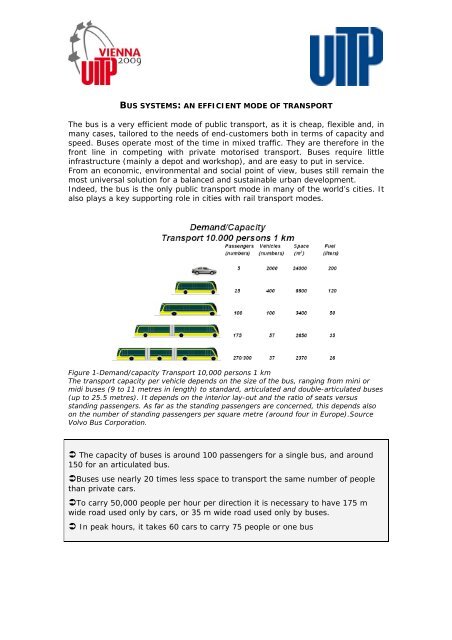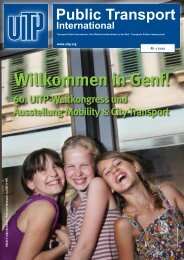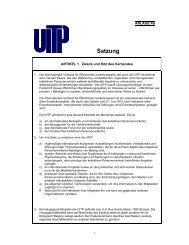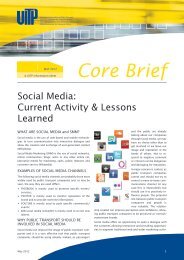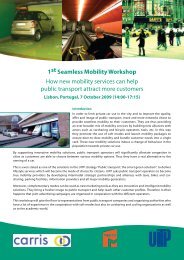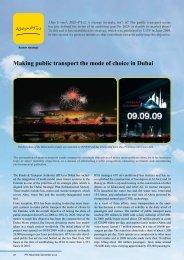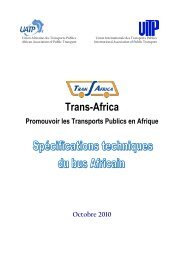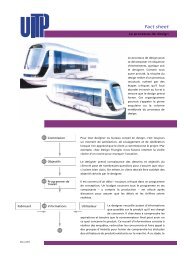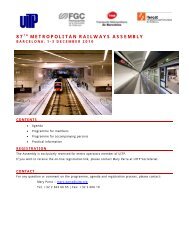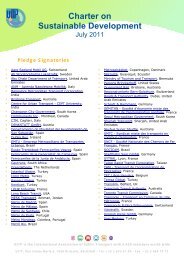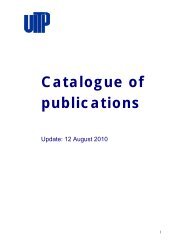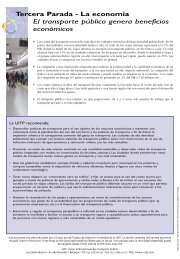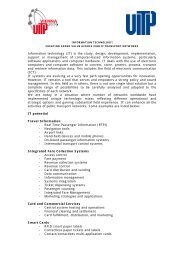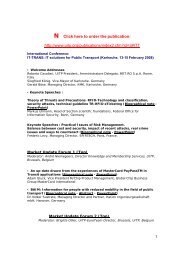Bus Systems: An efficient mode of transport - UITP
Bus Systems: An efficient mode of transport - UITP
Bus Systems: An efficient mode of transport - UITP
- TAGS
- efficient
- uitp
- www.uitp.org
You also want an ePaper? Increase the reach of your titles
YUMPU automatically turns print PDFs into web optimized ePapers that Google loves.
BUS SYSTEMS: AN EFFICIENT MODE OF TRANSPORT<br />
The bus is a very <strong>efficient</strong> <strong>mode</strong> <strong>of</strong> public <strong>transport</strong>, as it is cheap, flexible and, in<br />
many cases, tailored to the needs <strong>of</strong> end-customers both in terms <strong>of</strong> capacity and<br />
speed. <strong>Bus</strong>es operate most <strong>of</strong> the time in mixed traffic. They are therefore in the<br />
front line in competing with private motorised <strong>transport</strong>. <strong>Bus</strong>es require little<br />
infrastructure (mainly a depot and workshop), and are easy to put in service.<br />
From an economic, environmental and social point <strong>of</strong> view, buses still remain the<br />
most universal solution for a balanced and sustainable urban development.<br />
Indeed, the bus is the only public <strong>transport</strong> <strong>mode</strong> in many <strong>of</strong> the world’s cities. It<br />
also plays a key supporting role in cities with rail <strong>transport</strong> <strong>mode</strong>s.<br />
Figure 1-Demand/capacity Transport 10,000 persons 1 km<br />
The <strong>transport</strong> capacity per vehicle depends on the size <strong>of</strong> the bus, ranging from mini or<br />
midi buses (9 to 11 metres in length) to standard, articulated and double-articulated buses<br />
(up to 25.5 metres). It depends on the interior lay-out and the ratio <strong>of</strong> seats versus<br />
standing passengers. As far as the standing passengers are concerned, this depends also<br />
on the number <strong>of</strong> standing passengers per square metre (around four in Europe).Source<br />
Volvo <strong>Bus</strong> Corporation.<br />
� The capacity <strong>of</strong> buses is around 100 passengers for a single bus, and around<br />
150 for an articulated bus.<br />
�<strong>Bus</strong>es use nearly 20 times less space to <strong>transport</strong> the same number <strong>of</strong> people<br />
than private cars.<br />
�To carry 50,000 people per hour per direction it is necessary to have 175 m<br />
wide road used only by cars, or 35 m wide road used only by buses.<br />
� In peak hours, it takes 60 cars to carry 75 people or one bus
Emissions and energy<br />
As far as the green house effect is concerned, buses perform much better than<br />
cars since the emissions per passenger/km <strong>of</strong> CO2 equivalent gases are reduced,<br />
as shown below.<br />
0 50 100 150 200<br />
PT <strong>Bus</strong>/Hybrid (Rush Ho.)<br />
PT <strong>Bus</strong> (Rush Hour)<br />
PT <strong>Bus</strong> (Fleet Average)<br />
Car (8 l/100km; 1,2 Passg.)<br />
Car (10 l/100km;1,2<br />
Passg.)<br />
Figure 2- Emissions per passenger-km <strong>of</strong> CO 2 equivalent gases Source VDV<br />
The energy consumption <strong>of</strong> the bus per passenger/km is one-third <strong>of</strong> that <strong>of</strong> a car.<br />
Commercial speed: a key driver<br />
One <strong>of</strong> the main factors orientating an individual’s choice <strong>of</strong> <strong>transport</strong> <strong>mode</strong> is<br />
commercial speed/travel time. Over the past decades, increased road space<br />
consumption by private individual motorised <strong>transport</strong> has contributed to<br />
tremendous congestion. This has a direct impact on the operation speed <strong>of</strong> buses,<br />
and hence their service quality, reliability, energy consumption, economy and<br />
overall pr<strong>of</strong>itability.<br />
City<br />
<strong>Bus</strong> speed<br />
(in km/h)<br />
Reference area<br />
Helsinki 26<br />
Yhteistyovaltuuskunta including Helsinki + Espoo +<br />
Vantaa + Kauniainen<br />
Copenhagen 21.6 Greater Copenhagen region<br />
Warsaw 21.5 City <strong>of</strong> Warsaw<br />
Madrid 21 Comunidad de Madrid<br />
Bern 20.2 Planning Region Bern (24 municipalities)<br />
Berlin 19.5 State <strong>of</strong> Berlin (Land Berlin)<br />
Vienna 19 City <strong>of</strong> Vienna<br />
London 18 Greater London<br />
Stockholm 18 Stockholms Lan<br />
Lisbon 17.4 Area Metropolitana de Lisboa<br />
Paris 17.1 Ile-de-France Region<br />
Budapest 16.2<br />
Municipality <strong>of</strong> Budapest (Fopolgarmesteri Hivatal<br />
Budapest)<br />
Athens 16 Attika region<br />
Rome 15.4 Commune <strong>of</strong> Rome<br />
Dublin 14.6<br />
Dublin Region (Dublin City Centre and counties <strong>of</strong><br />
Fingal, South Dublin and Dún Laoghaire-Rathdown)<br />
Source: Mobility in Cities Database © <strong>UITP</strong> 2006 Please quote the source when using the<br />
data. Reference year is 2001. Reference areas are metropolitan areas and comparisons<br />
should take into account different configurations <strong>of</strong> metropolitan areas.<br />
2
The commercial speed with which buses can circulate in a bus system directly<br />
determines their energy consumption. The schema below details the different<br />
influential elements.<br />
Schematic graph showing the influential factors on the average commercial speed and its<br />
interrelation with the fuel consumption <strong>of</strong> buses . Graph extracted from <strong>UITP</strong>’s project<br />
SORT.<br />
Standardised fuel consumption measurements with SORT cycles show the<br />
tremendous effect <strong>of</strong> the average commercial speed on the fuel consumption on a<br />
busline. Indeed, the faster the average speed is, the lower the fuel consumption.<br />
litres/100 km<br />
70<br />
65<br />
60<br />
55<br />
50<br />
45<br />
40<br />
13 km/h<br />
14 km/h<br />
Consumption vs. Commercial speed<br />
15 km/h<br />
16 km/h<br />
17 km/h<br />
18 km/h<br />
19 km/h<br />
Commercial speed<br />
20 km/h<br />
21 km/h<br />
22 km/h<br />
23 km/h<br />
24 km/h<br />
25 km/h<br />
26 km/h<br />
27 km/h<br />
Source: <strong>UITP</strong> SORT method. The points in the graph correspond with SORT 1,<br />
SORT 2 and SORT 3.<br />
3
The importance <strong>of</strong> dedicated spaces<br />
The efficiency, speed and performance <strong>of</strong> buses depend heavily on dedicated<br />
lanes and stops. Various forms <strong>of</strong> traffic segregation are possible - from a mere<br />
painted mark on the road, to various forms <strong>of</strong> road treatments (elevated lanes,<br />
movable barriers, ‘bus locks’, contra flow lanes etc), to dedicated dual lane<br />
infrastructure with ‘metro-like stations’. The most advanced <strong>of</strong> such systems is<br />
referred to as ‘<strong>Bus</strong> Rapid Transit’ (BRT).<br />
Recent innovations<br />
Some key innovations include:<br />
• ‘<strong>Bus</strong> Rapid Transit’<br />
• Clean engines and alternative fuels<br />
• Low-floor architecture<br />
• Double articulated vehicles: up to 210 passengers<br />
• Guiding devices<br />
A recent trend is also to look beyond vehicle technology alone and to consider the<br />
wider system and its components, such as infrastructure and operations. This is<br />
commonly known and promoted as the ‘bus system approach’.<br />
European <strong>Bus</strong> System <strong>of</strong> the Future<br />
In recognition <strong>of</strong> the importance <strong>of</strong> bus systems and the challenges ahead the<br />
‘European <strong>Bus</strong> System <strong>of</strong> the Future (EBSF)’ project was launched in September<br />
2008 under <strong>UITP</strong> leadership. It is one <strong>of</strong> the largest surface <strong>transport</strong> R&D<br />
projects ever started by the European Union, and is funded under the 7 th<br />
Framework Programme (its total budget is around EUR 26 million).<br />
For the first time, this project brings together the five leading European bus<br />
manufactures (Evobus/Mercedes, Irisbus Iveco, MAN, Scania, Volvo) and 42 other<br />
partners including <strong>transport</strong> operators and national <strong>transport</strong> associations, public<br />
<strong>transport</strong> authorities, the supply industry and major research centres,<br />
universities and consultancy firms. The main objectives <strong>of</strong> EBSF are:<br />
• To conceive and develop an innovative high quality bus system which is<br />
fully integrated within the urban environment and that will demonstrate the<br />
full potential <strong>of</strong> a new generation <strong>of</strong> urban bus networks.<br />
• To make a breakthrough design <strong>of</strong> vehicles, infrastructures and operations.<br />
• To maintain or improve the competitive position <strong>of</strong> the European bus<br />
manufacturers and operators by promoting a new concept under the brand<br />
‘the European <strong>Bus</strong> System’.<br />
More information is available on: www.ebsf.eu<br />
Visit the <strong>UITP</strong> website for more information on the <strong>Bus</strong> division:<br />
www.uitp.org/Public-Transport/bus/index.cfm<br />
Notes for Editors<br />
<strong>UITP</strong>’s World Congress and Exhibition will be held in Vienna, Austria, 7-11 June 2009. The<br />
theme <strong>of</strong> the event is ‘Public <strong>transport</strong>: Making the right mobility choices’. For more<br />
information, visit www.uitp.org/vienna2009/.<br />
See the congress programme: www.uitp.org/vienna2009/Congress/programme-en.cfm<br />
See the Expo Forums programme: www.uitp.org/vienna2009/Congress/Expo-Forumsen.cfm<br />
Get a preview <strong>of</strong> the exhibition: www.uitp.org/vienna2009/Congress/Expo-Forums-en.cfm<br />
Visit the Vienna Congress and Exhibition Media Room:<br />
www.uitp.org/vienna2009/news/index.cfm<br />
Press Contact: Aline Talabard| <strong>UITP</strong> Communications Manager<br />
Direct phone: +32 (0)2 6636672 | Fax: +32 (0)2 6601072 | aline.talabard@uitp.org<br />
4
<strong>Bus</strong> systems during the 58 th <strong>UITP</strong> World Congress and Exhibition<br />
Tuesday 9 June 2009 14:00-15:30 SESSION 6<br />
Pr<strong>of</strong>itable bus systems: selected business <strong>mode</strong>ls<br />
This session will showcase some world class examples <strong>of</strong> self-supporting bus<br />
systems challenging the commonplace assumption that public <strong>transport</strong> systems<br />
are bound to be structurally in deficit. The conditions to increase the<br />
attractiveness <strong>of</strong> the sector for users and investors will be investigated as well as<br />
the <strong>efficient</strong> business <strong>mode</strong>ls that are used.<br />
Chair: David Martin, CEO, Arriva plc., Sunderland, United Kingdom<br />
• Productivity <strong>of</strong> the CISA <strong>Bus</strong> System in Mexico<br />
Jesús Padilla Zenteno, General Manager, Corredor Insurgtentes S.A. de C.V.,<br />
Mexico Ciy, Mexico<br />
• Tender Recommendations for the procurement <strong>of</strong> new buses<br />
Lars Johansson, Director Global Product Marketing, Volvo <strong>Bus</strong> Corporation,<br />
Gothenburg, Sweden<br />
• KGL approach in developing pr<strong>of</strong>itable bus services in the Middle East<br />
Khaled Al Awadhi, General Manager, KGL Passenger Transport Services, Safat,<br />
Kuwait<br />
• Environmental friendliness and pr<strong>of</strong>itability <strong>of</strong> PT systems do not need to be<br />
contradictory<br />
Holger Suffel, BRT Solution - Daimler <strong>Bus</strong>es, Evobus GmbH, Stuttgart,<br />
Germany<br />
Tuesday 9 June 11:00-12:30 Expo Forum 6<br />
The hybrid drive is here!<br />
Moderator: Arno Kerkh<strong>of</strong>, Senior Manager <strong>Bus</strong> Division, <strong>UITP</strong>, Brussels, Belgium<br />
• Developing a full range <strong>of</strong> hybrid diesel-electric buses<br />
Sven Somers, VAN HOOL NV Project Engineer<br />
• On the road to emission-free urban buses - CITARO BlueTec@ Hybrid<br />
Richard Averbeck, Evo<strong>Bus</strong>, Executive Managing Director<br />
• The Solaris Urbino 18 Hybrid: Leading in Experience<br />
Wolfgang Presinger, Solaris <strong>Bus</strong> & Coach S.A., Senior Advisor to the Board<br />
• MAN Hybrid City <strong>Bus</strong> - from Prototypes to Series Production<br />
Rolf Döbereiner, MAN, Head <strong>of</strong> development alternative<br />
Tuesday 9 June 16:00-17:30 Expo Forum 9<br />
Greener and more <strong>efficient</strong> city buses with advanced components<br />
Moderator: Arno Kerkh<strong>of</strong>, Senior Manager <strong>Bus</strong> Division, <strong>UITP</strong>, Brussels, Belgium<br />
• Latest Aspects <strong>of</strong> Driveline Development for City <strong>Bus</strong>es<br />
Joachim Foth, ZF Friedrichshafen AG, Director Product Development<br />
Powershift Transmission<br />
• HJS Exhaust-Aftertreatment-<strong>Systems</strong> - New Technologies for clean buses<br />
Axel Middendorf, HJS Fahrzeugtechnik GmbH & Co KG, Head <strong>of</strong> Sales<br />
5
• Voith Solutions for More Value for the Environment<br />
Robert Mueller, Voith Turbo GmbH & Co KG, General Manager Aftermarket<br />
<strong>Bus</strong>iness<br />
• Sustainable Public Transport with hybrid technology<br />
Martin Schmitz, Vossloh Kiepe GmbH, Vice-president<br />
Wednesday 10 June 09:00-10:30 Expo Forum 10<br />
<strong>Bus</strong> solutions for various operator demands<br />
Moderator: Arno Kerkh<strong>of</strong>, Senior Manager <strong>Bus</strong> Division, <strong>UITP</strong>, Brussels, Belgium<br />
• How to meet the future challenges <strong>of</strong> bus public <strong>transport</strong>: a concrete<br />
approach with Hynovis<br />
Valery Cervantes, Irisbus Iveco, Public Affairs<br />
• Sustainable Transport - A one-Stop-Shop <strong>Systems</strong> Solution<br />
Jonas Strömberg, SCANIA, Director Sustainable <strong>Systems</strong><br />
• TEMSA AVENUE – the new City<strong>Bus</strong> <strong>of</strong> Temsa<br />
Louis Kern, TEMSA EUROPE, Product advisor<br />
• Sustainable fuels and <strong>efficient</strong> public <strong>transport</strong> - balancing sustainability and<br />
energy<br />
Edward Jobson, Volvo <strong>Bus</strong> Corporation, Environmental Director<br />
Thursday 11 June 2009 09:00-10:30 SESSION 22<br />
Identifying energy savers for consumption in the bus and along the line<br />
The session will highlight methods and techniques to monitor and measure fuel<br />
consumption taking into account all the influential factors: not only vehicle<br />
performance but also weight, vehicle load, boarding time, road topography, traffic<br />
lights and congestion; in order to identify the best potentials for energy saving.<br />
Chair: Ezio Castagna, General Manager, CTM S.p.A., Cagliari, Italy<br />
• Energy-saving solutions, including hybrid buses<br />
Henri Bordenave, Responsable Ingénierie Autobus, RATP, Paris, France<br />
• Comprehensive sustainable Fuel Drive concepts for public service bus systems<br />
Ralph Pütz, Fachbereichsleiter Kraftfahrzeuge, Trolleybusse, Betriebshöfe und<br />
Werkstätten, VDV, Köln, Germany<br />
• Reducing energy consumption in Hong Kong's buses<br />
Kane Shum; Principal <strong>Bus</strong> Engineer, The Kowloon Motor <strong>Bus</strong> Co Ltd, Hong<br />
Kong, China<br />
Panellists:<br />
• Georges Despaigne, Responsable Filière Production, Département Innovation<br />
Métier et Produit, Transdev SA, Issy-les-Moulineaux, France<br />
• Rolf Hedberg, Product Manager, Scania CV AB, Södertalje, Sweden<br />
• Valéry Cervantes, Responsable des Affaires Publiques, Irisbus Iveco,<br />
Saint Priest, France<br />
• Richard Averbeck, Executive Managing Director Product Engineering, Evobus<br />
GmbH, Ulm, Germany<br />
• Eberhard Hipp, Senior Department Manager, MAN Nutzfahrzeuge, Munich,<br />
Germany<br />
6
Exhibitors include (April 2009)<br />
• Belkommunmash<br />
• Breda Manarini<br />
• Foton<br />
• Kutsenits<br />
• MAN<br />
• MAZ<br />
• Mercedes<br />
• Scania<br />
• Solaris<br />
• SOR Libchavy<br />
• Tedom<br />
• Temsa<br />
• Trans- Alfa<br />
• Van Hool<br />
• VDL<br />
• Volvo<br />
• Volzhanin<br />
• Youngman<br />
7


